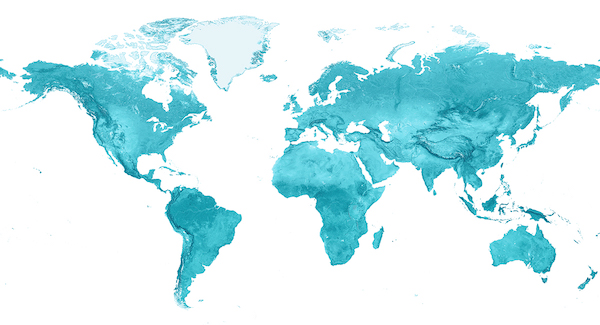
Region of Origin

Commodity:
Banana
Description & Origin
Botanically, bananas are the berry of a tree that looks like a palm but is actually a huge herb with a woody stem. The bananas (called “fingers”) grow from a hanging stem in groups (called “hands”) that together form a large bunch. The first bananas were full of seeds and contained very little flesh, but today’s cultivated varieties have been bred for seedlessness and you will rarely find a seed. ...
Other Names
Dessert Banana, Plátano (Spanish)
Health Benefits & Nutrition
Bananas are an exceptionally nutritious food. They contain high amounts of iron and potassium, making them beneficial for those suffering from anemia or the risk of high blood pressure. They contain high amounts of vitamin B, vitamin C, fiber, and magnesium and have trace amounts of phosphorus, calcium, zinc, cooper, and selenium. They are considered an excellent source of the amino acid tryptophan, as well as vitamin B6, which both help the body produce serotonin. Bananas have little fat and are low in calories. The average cavendish banana contains about 95 calories.
Our Varieties

Banana Burro
AKA: Orinoco, Bluggoe, Chunky Banana, Horse Banana, Hog Banana
Description
Burro bananas are about six inches long with a curved shape similar to the cavendish, but flatter and squarer. Their peel is vivid, dark green when immature, and deep yellow with black spots after it ripens. The flesh has a creamy texture and varies in color from white to yellow depending on maturity. When young, this banana has tart and tangy flavors with notes of apple and lime. As the fruit overripens, the yellow flesh becomes soft on the outside with a slightly-crisp textured center. This banana is prized for its lemon-like flavor and creamy sweetness.
Variety Tips & Tricks
Burro bananas are known as a dual-purpose variety. They can be enjoyed fresh when fully ripe (50% black) or used green like a plantain and incorporated into both sweet and savory preparations.
Commercial Availability (Grown for the US Market)

Banana Cavendish
AKA: Yellow Banana
Description
Cavendish bananas are the most common variety of banana found at supermarkets around the developed world. Produced on huge plantations, the cavendish variety was selected for its incredible consistency and resistance to a common and fatal fungal disease affecting bananas, Panama Disease. Their thick yellow peel surrounds a creamy, white-colored flesh that’s firm and astringent when immature, becoming softer and sweeter as it ripens. The cavendish banana is exceptionally mild with only very light tropical notes. The eating experience is dominated by the creamy texture and simple sweetness.
Variety Tips & Tricks
Cavendish bananas are known as the “fresh-eating banana” because they are most commonly enjoyed raw. Because of their mildness, they are also considered a standard among dessert bananas; just slice or mash the flesh and incorporate it into various desserts.
Commercial Availability (Grown for the US Market)

Banana Green
AKA: Cookers, Cooking Bananas, Guineos Verde (Caribbean)
Description
Green bananas are unripe cavendish-type bananas that have been specially grown and harvested in order to resist the ripening process through the supply chain. They are an important part of Caribbean cooking, especially Puerto Rico and the Dominican Republic, alongside their cousin, the starchy plantain. Green bananas must be cooked before they can be consumed, as they are very starchy. Their flavor is mild, but hearty.
Variety Tips & Tricks
Use green bananas quickly to prevent any unwanted ripening. They can be stored in a warm area of the refrigerator to slow the ripening process. Excellent in hearty Caribbean stews, tostones, and traditional pasteles.
Commercial Availability (Grown for the US Market)

Banana Manzano
AKA: Latundan, Apple Banana, Silk Banana, Pisang Rastali (Malaysia), Tundan (Phillippines)
Description
The manzano banana is a stubby, thick-skinned, golden yellow fruit that is commonly known as the “apple banana” due to its apple-like aftertaste. It is one of the most popular dessert bananas in the Philippines. This variety is short, plump, and finger-sized. It’s exceptionally sweet and very fragrant.
Variety Tips & Tricks
These small bananas are sweetest when the skin turns completely black, but they can be eaten when 50-100% black.
Commercial Availability (Grown for the US Market)

Banana Thai
AKA: Gluay Naam Waa/Kluay Nam Wah (Thailand), Pisang Awak (Malaysia), Bulkan (Thailand)
Description
There are more than 50 varieties of banana grown in Thailand, but the only one currently available in the US is the gluay naam waa, one of Thailand’s most common varieties. This short, stubby, sturdy banana is a dual-purpose banana: it is often used when green for cooking, but can also be eaten when ripe as a dessert banana. The flesh is dense and sticky with an almost bubblegum-like flavor. They may occasionally have seeds. They are usually shipped with the central stem of the hand still intact.
Variety Tips & Tricks
Use unripe Thai bananas as soon as possible, as they are quick to ripen. In Thailand, they are often fried when green. If you are planning to use them ripe, wait until they are fully yellow with about 50% blackening.
Commercial Availability (Grown for the US Market)
Foodservice Tips
Traditional Culinary Uses
Bananas are the world’s most consumed fruit. Some varieties are consumed as “dessert” bananas, meaning they are eaten when sweet and ripe. Others are eaten as cooking bananas when green, starchy, and underripe. Some varieties can be eaten either way! Dessert bananas are typically eaten out of hand or used to make fritters or other sweets. In East and Central Africa, sweet bananas are even used to make beer or wine. Cooking bananas are a staple food throughout the tropics and play a central role in a huge range of stews, soups, sides, and fried dishes.
Flavor Pairings
Pineapple, Apple, Guava, Mango, Stone Fruit, Berry, Citrus, Mint, Lemongrass, Chiles, Nuts, Cinnamon, Nutmeg, Granola, Chocolate, Vanilla, Caramel, Yogurt, Cream, Bacon, Black Beans, Chicken, Pork
How to Store & Use in the Kitchen
Green bananas meant for cooking should be stored as close to 56°F as possible, but not under, and used as soon as possible. Keep away from any other ripening bananas or other ethylene-producing fruit to avoid ripening. Dessert bananas can be stored at room temperature. To slow ripening, ensure bananas are stored in a cool place with good airflow. To speed ripening, bananas can be stored in a paper or plastic bag.
To use dessert bananas, just peel the skin back. Green bananas can be boiled whole before peeling so it is easier to remove the skin. Bananas can be frozen whole or peeled.
Fight Food Waste Tips for root to stem cooking
Don’t throw away that peel! Banana peels contain antioxidant phenolics, antibacterial compounds, bioactive carotenoids, and anti-inflammatory properties. Some suggest they can be used to whiten teeth, relieve sunburns, reduce wrinkles, fade acne scars, shine hair, polish leather, or fertilize a garden. The peels are also edible – deep fry or candy and turn into a fun vegan bacon substitute.
Warehouse Storage & Handling
Maintain these conditions for optimal short-term storage shelf life.*
IDEAL STORAGE TEMP:
56-58°F
RECOMMENDED TEMP STORAGE ZONE:
55-60°F (Warm Storage)
SUBJECT TO CHILLING INJURY:
Yes - bananas are very sensitive to cold temps and can suffer when stored at 55°F and below. Symptoms include discoloration and failure to properly ripen.
RELATIVE HUMIDITY:
90-95%
PRODUCES ETHYLENE:
Yes-High - bananas produce more ethylene as they ripen.
SENSITIVE TO ETHYLENE:
Yes-High
ETHYLENE RECOMMENDATIONS:
Bananas should be kept far from any products sensitive to ethylene. Cooking bananas should NOT be stored near ripening bananas.
RIPENS AFTER HARVEST:
Yes
PROFESSIONAL RIPENING RECOMMENDED:
Yes – professional conditioning is required for bananas to properly ripen.
Quality Assessment
Bananas should be free from major scarring and insect injury, but some brown or black spotting is normal in non-cavendish varieties.
Important Handling Notes
Bananas are a finicky fruit. Be sure to store in an area with good ventilation and prevent exposure to ethylene and fluctuating temperatures. Green bananas should be stored as close to 56°F as possible.
They are susceptible to bruising if handled roughly. Note that certain varieties are meant to be consumed when totally black, with almost no trace of yellow remaining. Buy fruit at the appropriate stages and avoid holding inventory or attempting tricky DIY backroom ripening.
Optimum Shelf Life
Depending on variety, conditions at harvest, and handling, bananas may last 2-4 weeks.

